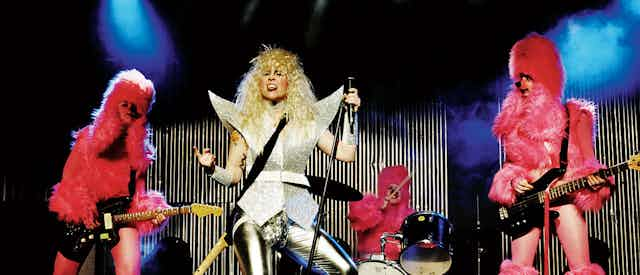The first Scottish Queer International Film Festival (SQIFF) kicks off on the evening of Thursday September 24 with the UK premiere of Dyke Hard. It is a Swedish musical-action-horror-sci-fi-comedy about a failed lesbian rock group hoping that a battle of the bands contest will set them on the road to success. Followed by a Q&A with director Bitte Anderson, it will raise the curtain on a four-day festival in Glasgow that includes more than 30 features, documentaries, shorts, workshops and, of course, parties.
SQIFF is actually the second LGBTI film festival to be taking place in Scotland this year. It follows Glitch 2015, another inaugural event in Glasgow over ten days in March that billed itself as Scotland’s first “queer, trans, intersex, people of colour” film festival. With two similar events getting underway at almost the same time in a country that previously had none, it begs the questions: why Scotland and why now?
Scotland has both a rich cinematic history and a strong appetite for film. Attendances at cinemas and film festivals have risen substantially in recent decades, with cinema attendance per head the second highest in Europe after France. The country hosts more than 30 film festivals each year, ranging from industry-focused international events like the Edinburgh International Film Festival to community-focused boutique festivals.
With this vibrant film culture and a fairly liberal cultural climate, it’s astonishing that Scotland has until now been conspicuous by its absence on the global map of more than 300 LGBTI film festivals.
Until now Scotland has made do with a number of films of LGBTI content at the two premier film events, the Edinburgh International Film Festival and Glasgow Film Festival. Last year’s Glasgow Film Festival programmed a number of films that were also screened on the global queer film-festival circuit, for example, including Appropriate Behaviour, The Falling, Girlhood, 52 Tuesdays and The New Girlfriend.
The broader context is that LGBTI culture has gained considerable mainstream visibility in recent years. We might think of Todd Haynes’s Carol making a splash at Cannes this year and Blue is the Warmest Colour winning the Palm D’Or in 2013. We have also seen high-profile US TV series Orange is the New Black, Transparent and Looking, along with Channel 4’s Cucumber in the UK.
Yet leading queer film scholar and critic B Ruby Rich criticised these kinds of programmes at a recent conference in Hamburg. She argued that while they do help LGBTI culture to be more visible, the fact that they are mainly available through online streaming platforms such as Netflix and Amazon means they tend to be watched on a very individual basis rather than helping build any shared sense of community. And this is not only the case for TV programmes, but for the majority of LGBTI-themed films as well. In this context, queer film festivals become a way of filling the gap that this creates.
LGBTI film festivals in five stages
To understand where the new Scottish film festivals fit into this picture, it is worth explaining the five relatively distinct phases through which queer film festivals have developed:
1. Late 1970s and 1980s Queer film festivals were established as oppositional, grassroots and identity-based “gay & lesbian” film events – first in the US and then in western Europe. This took place as part of the wider socio-political movement against minority oppression that led to women’s and black film festivals in the same era.
2. Early to mid-1990s Queer cinema became a credible cinematic movement with the rise of “new queer cinema” through films like Poison, Young Soul Rebels, Swoon and The Watermelon Woman. This led to the growth of a queer film festival circuit in north America and western Europe, and to closer relationships between festivals and the commercial film industry.
3. Late 1990s to early 2000s Queer film festivals spread to eastern Europe and Asia in the late 1990s and early 2000s in a sort of queer globalisation.
4. Mid-2000s Queer film festivals started attracting larger corporate sponsorship deals and began to have more financial interests in common with the mainstream media – television in particular, where programmes featuring LGBTI characters such as Will & Grace and Queer as Folk were being produced. We also saw the growth of queer film festivals in Latin America.
5. Late 2000s to present Since 2007 the number of queer film festivals has been steadily growing to include a greater number of smaller “niche” festivals – Glitch’s focus on people of colour would be a good example. This differentiation has coincided with a period of greater and more diverse representation of LGBTI culture in the mainstream.
It is in response to these developments that both SQIFF and Glitch have come into being. Both festivals position themselves very much against the mainstreaming and commercialisation of LGBTI cinema and culture. They are more than just spaces that provide representations. In a world where the mainstream is threatening to fragment the community, they provide viewing spaces where LGBTI people can come together and celebrate their diversity – as well as offering opportunity to stay true to the political and activist roots from which such film festivals emerged in the first place.
In this context, both SQIFF and Glitch represent a desire for an alternative to what was once itself alternative. So let the credits roll.

